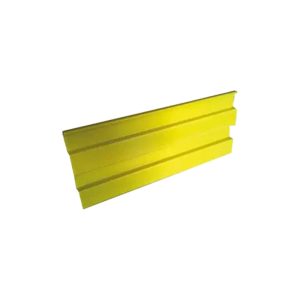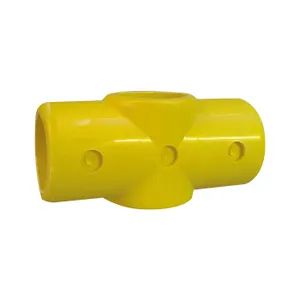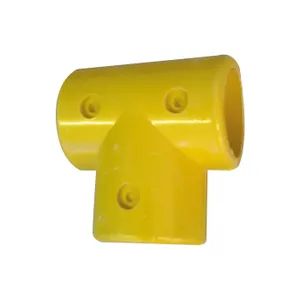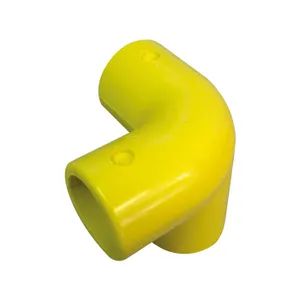Nosso sistema de corrimão GRP frequentemente usado em um corrimão ou corrimão GRP para continuar o corrimão intermediário em um canto de 90° ou conectar postes verticais ao trilho superior ou para unir o corrimão intermediário ao poste final.
Introdução ao desempenho do produto
|
|
O GRP externo Swivel é um acessório giratório em linha versátil, frequentemente usado onde os ângulos variam em declives, degraus e aterrissagens. |
|
O GRP 116 Mid Corner é uma junta de canto de 90°, frequentemente usada em um corrimão ou guarda-corpo GRP para continuar o trilho intermediário em um canto de 90°, mas também pode ser usado para construir estruturas retangulares ou quadradas. A vertical passa verticalmente através do encaixe GRP. Frequentemente usado com o canto superior GRP-128. |
|
|
O GRP 101 Short Tee é uma conexão em T de 90°, normalmente usada em um corrimão GRP para conectar postes verticais ao trilho superior ou para unir o corrimão intermediário ao poste final. O tubo não pode ser unido na parte superior da conexão - o GRP-104 Long Tee pode ser usado como alternativa, se necessário. |
|
O GRP Fitting 119 Midrail Cross é uma junta de 90°, frequentemente usada para unir o trilho intermediário a um poste vertical intermediário em um corrimão ou guarda-corpo GRP. A vertical passa verticalmente através do encaixe GRP. |
|
|
O GRP 104 Long Tee é uma conexão em T de 90°, normalmente usada para conectar postes verticais ao trilho superior de um corrimão GRP. O GRP -104 pode ser usado onde dois comprimentos de tubo precisam ser unidos na parte superior da conexão. |
|
A conexão GRP 125 é um cotovelo de 90°, frequentemente usado em um corrimão ou guarda-corpo GRP para conectar o trilho superior ao poste vertical no final de uma corrida. |
|
|
O GRP 129 é um encaixe em T de 30°, frequentemente usado em um corrimão ou guarda-corpo GRP de escada. |
|
A conexão 128 Top Corner é de 3 vias. Cotovelo de 90°, normalmente usado para unir um poste vertical ao trilho superior de um corrimão GRP em um canto de 90°. Frequentemente usado com o GRP-116 Mid Corner. |
|
|
O GRP 130 é uma cruz de 30°, frequentemente usada para conectar o corrimão intermediário a postes intermediários em um corrimão de escada GRP. |
|
O GRP 116 Mid Corner é uma junta de canto de 90°, frequentemente usada em um corrimão ou guarda-corpo GRP para continuar o trilho intermediário em um canto de 90°, mas também pode ser usado para construir estruturas retangulares ou quadradas. A vertical passa verticalmente através do encaixe GRP. Frequentemente usado com o canto superior GRP-128. |
|
|
A Placa de Base GRP 132 é uma flange de base com quatro furos de fixação, utilizada para fixar os postes verticais em um corrimão ou guarda-corpo. |
|
O GRP 173 Single Swivel é um acessório giratório versátil, usado onde os ângulos variam em declives, degraus e aterrissagens. |
|
|
A Tomada de Parede 145 é um Encaixe GRP projetado para fixação lateral de corrimãos ou guarda-corpos GRP em paredes, rampas e degraus. |  |
Nossa placa GRP Kick tem 100 mm de largura, com uma parede de 5 mm. É armazenado em comprimentos de 6m, mas pode ser cortado no comprimento, se necessário. |
Fabricado em plástico reforçado com fibra de vidro (GRP) na China, o sistema de corrimão GRP da TFcomposite oferece benefícios importantes sobre o aço que explicam por que você verá corrimãos GRP em todos os lugares, desde obras de tratamento de água até a indústria ferroviária.
Fiberglass Reinforced Plastic (FRP) handrail systems are advanced, durable solutions for safety and access in industrial, commercial, and architectural applications. They are valued for their strength, corrosion resistance, and low maintenance, making them ideal for environments where traditional materials like steel or wood might fail due to exposure to harsh elements. Below is an in-depth exploration of FRP handrail systems, their components, benefits, applications, installation processes, and maintenance.
1. What is an FRP Handrail System?
An FRP handrail system is a modular or pre-engineered safety barrier system made from fiberglass reinforced plastic, a composite material that combines strong fibers with a polymer matrix. This results in a product that is lightweight, strong, and resistant to corrosion, chemicals, and UV exposure.
Key Components
FRP handrail systems typically consist of:
- Rails: The horizontal components providing continuous support.
- Posts: Vertical elements anchored to the ground or structure to support the rails.
- Knee Rails: Secondary horizontal rails for additional support and safety.
- Toe Boards: Base-level components to prevent tools or debris from falling.
- Acessórios: Connectors, brackets, and fasteners that hold the system together.
- Bases and Mounts: Used to anchor the system to floors, walls, or other surfaces.
2. Materials and Manufacturing
FRP handrail systems are produced using two main manufacturing methods:
- Pultrusion:
- Continuous fibers are pulled through a resin bath and a heated die.
- Ensures uniform strength and a smooth finish.
- Moldagem:
- Fiberglass mats or woven roving are layered and infused with resin in a mold.
- Often used for complex or custom shapes.
Common Materials in FRP Handrails
- Fibers: Typically glass fibers for high tensile strength.
- Tipos de resina:
- Poliéster: Cost-effective and moderately resistant to chemicals.
- Éster vinílico: Higher resistance to chemicals and heat.
- Epoxy: Superior mechanical strength and adhesion.
Additives like UV inhibitors, fire retardants, and pigments can be incorporated to enhance performance and aesthetics.
3. Key Benefits of FRP Handrail Systems
FRP handrail systems offer several advantages over traditional materials:
3.1. Corrosion Resistance
- Ideal for environments exposed to chemicals, saltwater, or moisture.
- Used in wastewater plants, marine applications, and chemical processing facilities.
3.2. Lightweight and Easy Installation
- Weighs significantly less than steel or aluminum, reducing transportation and labor costs.
- Modular designs often allow for easy assembly without specialized tools.
3.3. High Strength-to-Weight Ratio
- Provides comparable or superior strength to traditional materials with less bulk.
3.4. Durability and Longevity
- Resists cracking, warping, and degradation over time.
- Long service life even in extreme conditions.
3.5. Low Maintenance
- Requires no painting or frequent inspections.
- Resistant to rust and biological growth.
3.6. Electrical and Thermal Insulation
- Non-conductive, making it safe for electrical environments.
- Low thermal conductivity reduces the risk of burns in high-temperature areas.
3.7. Customizability
- Available in various colors, sizes, and configurations to suit specific requirements.
- Aesthetic options enhance compatibility with architectural designs.
4. Applications of FRP Handrail Systems
FRP handrails are used across diverse industries due to their adaptability and robust properties. Below are examples of key application areas:
4.1. Industrial Facilities
- Plantas Químicas: Withstand chemical splashes and fumes.
- Oil and Gas: Non-corrosive properties ensure longevity in offshore and onshore facilities.
- Usinas de energia: Non-conductive properties provide safety in electrical substations.
4.2. Water and Wastewater Treatment Plants
- Resistant to chlorine, acids, and moisture.
- Ideal for walkways, platforms, and tank access.
4.3. Marine and Coastal Environments
- Unaffected by saltwater corrosion.
- Used on docks, piers, and offshore platforms.
4.4. Public Infrastructure
- Bridges, parks, and pedestrian walkways where safety and aesthetics are essential.
4.5. Commercial and Residential
- Balconies, staircases, and ramps requiring modern, low-maintenance railings.
5. Design Standards and Compliance
FRP handrail systems are often designed to meet rigorous safety and engineering standards, including:
-
OSHA (Occupational Safety and Health Administration):
- Ensures compliance with workplace safety guidelines for handrails.
- Requires specific height, strength, and deflection properties.
-
ASTM (American Society for Testing and Materials):
- Provides testing standards for strength, durability, and material performance.
-
ISO (International Organization for Standardization):
- Covers quality and environmental safety standards globally.
-
ADA (Americans with Disabilities Act):
- Mandates handrail accessibility features, such as smooth surfaces and appropriate height.
6. Installation of FRP Handrail Systems
Installing an FRP handrail system involves the following steps:
6.1. Preparation
- Assess site conditions and ensure the surface is clean and level.
- Mark installation points based on a pre-approved layout or engineering design.
6.2. Assembly
- Install base mounts or brackets at marked points.
- Attach posts to the base mounts using bolts or adhesives.
- Secure horizontal rails and knee rails to the posts using brackets and fasteners.
- Attach toe boards if required.
6.3. Finishing
- Tighten all connections and inspect for alignment.
- Apply sealants or coatings if additional protection is needed.
6.4. Safety Testing
- Perform load tests to ensure compliance with safety standards.
- Inspect for any loose connections or misalignments.
7. Maintenance of FRP Handrail Systems
FRP systems require minimal upkeep, but periodic checks can ensure maximum performance:
7.1. Cleaning
- Use mild soap and water to remove dirt, debris, or grease.
- Avoid abrasive materials to prevent surface scratching.
7.2. Inspection
- Check for loose fittings, bolts, or cracks in the material.
- Inspect joints and connections regularly.
7.3. Repairs
- Damaged components can often be replaced individually without dismantling the entire system.
- Use compatible adhesives or replacement parts from the manufacturer.
8. Customization Options
FRP handrail systems are highly customizable, allowing for adaptation to specific needs:
- Colors: Yellow, green, grey, or custom colors for branding or safety coding.
- Tamanhos: Varying rail diameters and post heights to meet specific requirements.
- Surface Finishes:
- Smooth for aesthetic purposes.
- Textured for slip resistance.
9. Cost Considerations
While the initial cost of FRP handrails may be higher than traditional materials, their long-term cost-effectiveness makes them an attractive option. Key cost factors include:
- Material grade (polyester vs. vinyl ester).
- Customization requirements.
- Installation complexity.
- Quantity and scale of the project.
10. FRP Handrail System vs. Traditional Materials
| Recurso | FRP Handrails | Steel Handrails | Aluminum Handrails |
|---|---|---|---|
| Resistência à corrosão | Excelente | Pobre | Moderado |
| Peso | Leve | Heavy | Leve |
| Maintenance | Baixo | Alto | Moderado |
| Força | Alto | Muito alto | Moderado |
| Condutividade elétrica | Non-conductive | Conductive | Conductive |
| Cost (Initial) | Moderate to High | Low to Moderate | Alto |
| Cost (Lifetime) | Baixo | Alto | Moderado |
11. Future Trends
- Enhanced Aesthetics: New pigments and coatings for modern designs.
- Sustentabilidade: Use of recycled or eco-friendly resins.
- Smart Systems: Integration of IoT sensors for safety monitoring.
Conclusão
FRP handrail systems are a superior choice for industries and environments requiring durability, safety, and low maintenance. Their adaptability and performance advantages over traditional materials make them a long-term investment for infrastructure and industrial facilities. By leveraging their modular design, ease of installation, and customization capabilities, FRP handrails continue to gain prominence in diverse applications.
Detailed Overview of FRP Handrail Systems
Series :
Principais Produtos >aplicativo
Nosso sistema de corrimão GRP é amplamente utilizado em corrimão GRP e conexão cruzada multi-drop-and-continue do corrimão de proteção.
Marca :
TFcomposite
Cor :
amarelo ou cinza
Perguntas frequentes
P:
Qual o tamanho e comprimento do tubo do corrimão GRP?
A :
O tubo GRP é produzido apenas em 50mm o/d (diâmetro externo) e é armazenado em comprimentos de 5m. Podemos cortar o tubo no comprimento, se necessário.
P:
Como as conexões são fixadas no tubo?
A :
As conexões para corrimãos GRP são fornecidas como duas metades idênticas que simplesmente se prendem ao redor do tubo. Eles precisam ser perfurados no local usando uma broca HSS padrão de 9 mm de diâmetro (fornecida com seu pedido) e aparafusados com as fixações especiais de aço inoxidável fornecidas. Os parafusos são então inseridos e apertados usando uma chave pozi 3, a fixação da porca serrilhada se manterá no lugar enquanto o parafuso é apertado. Essas fixações fornecem um acabamento nivelado sem cabeças de parafusos salientes.
P:
Quais cores estão disponíveis para sistemas de corrimão GRP?
A :
Armazenamos o tubo e as conexões em amarelo – para alta visibilidade – ou cinza.
Outros produtos relacionados
























